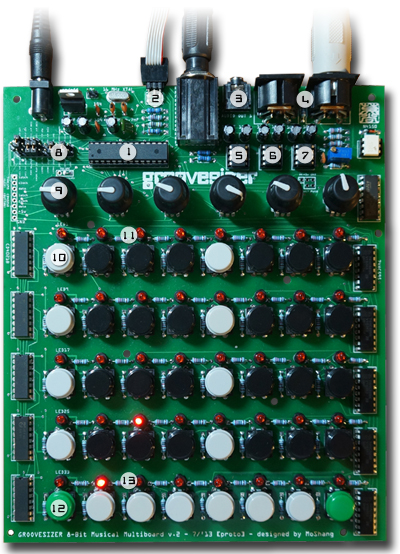The Groovesizer MB (for multiboard) is a DIY 8-bit audio platform. It’s a musical chameleon that can take on a number of different roles from sequencer to synth, drum machine, or midi controller. Exactly what the Groovesizer MB is at a given moment depends on the firmware it’s running. Existing firmware can be freely hacked, or new firmware developed using the beginner friendly Arduino IDE. Firmware is loaded to the board directly from the Arduino IDE, either via an AVR ISP programmer, or by flashing the Atmega chip on an Arduino board and swapping it out.
The Groovesizer MB is based around a custom PCB (the multiboard) that features 6 potentiometers and 5 rows of 8 tactile switches and leds (4 rows for the sequencer / trigger buttons and 1 row dedicated to control functions). It features an integrated Arduino clone, an 8-bit DAC option, an LM386 amp output, MIDI in/out/sync and is configurable to work with some of the most popular existing Arduino audio projects.
Furthest along in their development are the Alpha (3 oscillator monosynth) and the Delta (a granular synth based on the Auduino project). Both synths are attached to a 32-step sequencer with 112 memory locations to store patches and patterns.
Though currently only at the proof-of-concept stage, future firmware will include
- Bravo which borrows code from the Bleeplabs Bleepdrum
- Charlie, based around the Illutron 4-voice wavetable synth
- Echo, which uses the Mozzi library (HIFI mode) for sound generation
- and Foxtrot, a (mute) midi controller.
A sheet metal enclosure is now available.
(A Groovesizer in its eclosure is pictured here atop an Akai APC20 for scale).
The firmware is licensed under GPLv3 and the schematics for the multiboard (made available in the form of the original Fritzing project file) is licensed under CC-Attribution-ShareAlike. The Arduino code is thoroughly commented and should provide a perfect opportunity to learn about programming a synth and sequencer from the ground up.
In this video, noisythang demonstrates MIDI note entry as he uses the Groovesizer to sequence a Roland SH-32.
Groovesizer 8-Bit Musical Multiboard
1. Integrated Arduino clone
2. ICSP programming header
3. Audio outputs
4. MIDI input and output
5. DAC
6. Amplifier
7. EEPROM
8. Jumper matrix
9. Potentiometers
10. Step-select buttons
11. Step-select LEDs
12. Control buttons
13. Control LEDs


